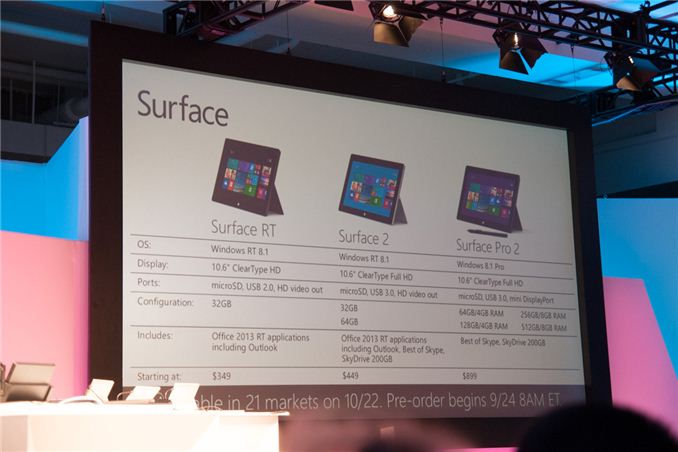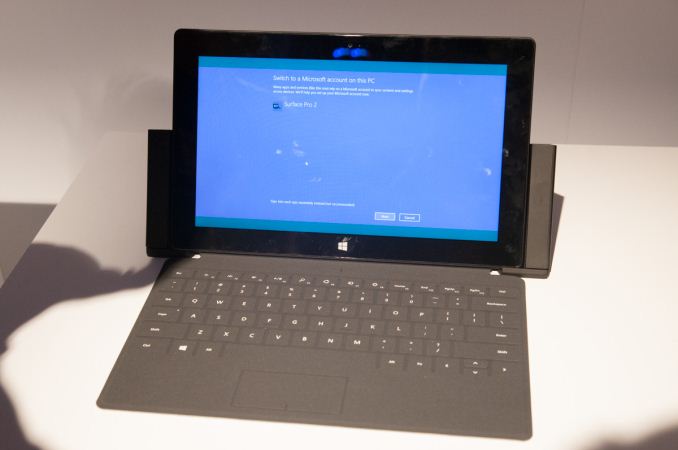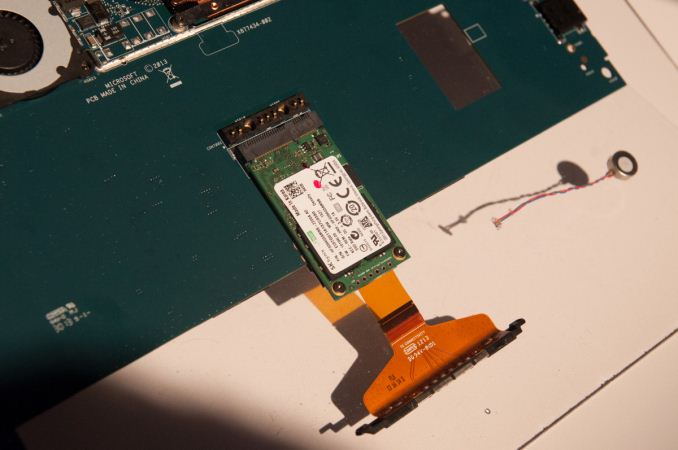Microsoft Announces Surface Pro 2 & Surface 2, Shipping October 22
by Anand Lal Shimpi & Brian Klug on September 23, 2013 12:37 PM EST
Microsoft just announced the long awaited successors to its Surface RT and Surface Pro devices at a press event in NYC. We were fans of the original Surface devices, however neither was quite perfect. It'll be a short while before we can actually review these things (they ship on October 22nd), but on paper we can already get a good indication of what Microsoft has done to both lines.
Surface 2
Surface RT is succeeded (not replaced) by Surface 2. The previous generation Surface RT model will remain on sale for $349, putting it at a very compelling price point in the 10-inch tablet market - especially considering that it comes with a full version of Office. The new Surface 2 takes its place at $449 and features a long list of upgrades. The display is now full 1080p with improved color accuracy compared to the outgoing model. Microsoft spent a lot of time last year talking about how it's 1366 x 768 panel was better than most thanks to its optically bonded display, but it's good to see a shift towards a higher resolution panel. The focus on improving color accuracy is important as well. In our original review of Surface RT I found its display to be ok, but hardly accurate. Given that both Apple and Google are now shipping relatively well calibrated tablet displays, it's key that Microsoft does the same. The only downside is it looks like the new display isn't full sRGB but rather a smaller gamut.
Internally Tegra 3 is out and replaced by Tegra 4. Just like last time, Tegra 4's 5th shadow core isn't exposed or used under Windows RT 8.1. Update: NVIDIA tells us the shadow core is enabled (contrary to what we originally heard from MS at the event), although it won't tell us how it's used. I know I was personally expecting a Snapdragon 800 based device, but those initial rumors also pointed to the Qualcomm based Surface tablet being smaller than 10.6-inches as well so it's entirely possible that we'll see Qualcomm show up at a later point. The move to Tegra 4 comes with four ARM Cortex A15 cores and a much better GPU. The combination of the two should deliver a much better experience on Surface 2 than with Surface RT. The latter was simply too slow, but I'm expecting big things from the Tegra 4 upgrade. Although I completely understand why Microsoft is interested in going with an ARM partner for Surface 2, I do wonder if it might've been a better idea from a power efficiency standpoint to use Intel's Bay Trail instead. Note that with Surface 2 Microsoft drops the RT from the device's name. We'll see what happens with Cherry Trail next year.
| Microsoft Surface 2/RT Comparison | ||||||||
| Surface 2 | Surface RT | Apple iPad 4 | ||||||
| Dimensions | 10.81 x 6.79 x 0.35" | 10.81 x 6.77 x 0.37" | 9.50 x 7.31 x 0.37" | |||||
| Display | 10.6-inch 1920 x 1080 w/ Improved Color Accuracy | 10.6-inch 1366 x 768 PLS | 9.7-inch 2048 x 1536 IPS | |||||
| Weight | Less than 1.49 lbs | 1.5 lbs | 1.44 lbs | |||||
| Processor | NVIDIA Tegra 4 1.7GHz | NVIDIA Tegra 3 |
Apple A6X |
|||||
| Connectivity | 802.11n WiFi | 802.11n WiFi | WiFi , Optional 4G LTE | |||||
| Memory | 2GB | 2GB | 1GB | |||||
| Storage | 32GB or 64GB eMMC | 32GB or 64GB | 16GB—128GB | |||||
| Battery | ? | 31.5 Wh | 42.5Wh | |||||
| Starting Price | $449 | $349 | $499 | |||||
Surface 2 retains the full sized USB port and microSD card slots on the device itself, although the former gets upgraded to USB 3.0. Internal storage options remain at 32GB or 64GB eMMC. Both front and rear facing cameras are improved over the original design as well.
The design of Surface 2 improves over its predecessor. Surface 2 is slightly thinner than its predecessor and is a little lighter as well. The device now features a silver colored VaporMg finish and a 2-stage kickstand. Although I loved the idea of the kickstand with the original Surface devices, I felt that it was often not at the right angle for me to use on anything other than a table. Surface 2's 2-stage kickstand should allow for some flexibility, although I'm curious to see how this works in practice and if there are any sacrifices to the overall stability of the stand.
Surface 2 will ship with Office 2013 RT including Outlook RT and come with 200GB of free Sky Drive storage for 2 years. The entire package starts at $449, but once again does not include a touch or type cover. The 64GB Surface 2 will sell for $100 more at $549.
Surface Pro 2
Surface Pro 2 sees a similar set of upgrades. It gets an updated display (the original Surface Pro was already 1080p) with better color accuracy. USB 3.0 support existed on the previous model as well. The big upgrade here is to a Haswell based Core i5-4200U. That's a 15W Haswell part (similar to what you'd find in an Ultrabook) but with Intel's HD 4400 graphics and not HD 5000. The move to 15W Haswell means there's no real reduction in device thickness with Surface Pro 2. This continues to be an interesting design decision on Microsoft's part. While I'd personally advocate for a lower wattage Y-series SKU, it could be that Microsoft feels the added performance of a full Ultrabook Haswell ULT SKU is necessary for Surface Pro's target market. Either way the move to Haswell should come with significant improvements in battery life (Microsoft claims a 75% improvement for Surface Pro 2, and 25% for Surface 2).
| Microsoft Surface Pro Comparison | ||||||||
| Surface Pro 2 | Surface Pro | Apple iPad 4 | ||||||
| Dimensions | 10.81 x 6.81 x 0.53" | 10.81 x 6.81 x 0.53" | 9.50 x 7.31 x 0.37" | |||||
| Display | 10.6-inch 1920 x 1080 w/ Improved Color Accuracy | 10.6-inch 1920 x 1080 PLS | 9.7-inch 2048 x 1536 IPS | |||||
| Weight | 2.0 lbs | 2.0 lbs | 1.44 lbs | |||||
| Processor | Core i5-4200U with HD4400 Graphics (15W Haswell ULT) |
Core i5-3317U with HD4000 Graphics (17W Ivy Bridge) |
Apple A6X |
|||||
| Connectivity | WiFi | WiFi | WiFi , Optional 4G LTE | |||||
| Memory | 4GB or 8GB LPDDR3 | 4GB | 1GB | |||||
| Storage |
64 or 128GB (4GB RAM) 256GB or 512GB (8GB RAM) |
64GB or 128GB | 16GB—128GB | |||||
| Battery | 42.0 Wh | 42.0 Wh | 42.5Wh | |||||
| Starting Price | $899 | $899 | $499 | |||||
Surface Pro 2 starts at $899 and now comes in four different configurations You can get Surface Pro 2 with a 64GB ($899) or 128GB SSD ($999) and 4GB of RAM, or if you want 8GB of RAM there are 256GB ($1299) and 512GB ($1799) versions as well. Surface Pro 2 retains the old front and rear cameras.
Interestingly enough, the internal shots of the Surface Pro 2 feature a SKhynix mSATA SSD. I wonder if it's using a Link_A_Media controller:
As you can see in the gallery below, the PCB for Surface Pro 2 is absolutely huge. I'm really curious to see why Microsoft went this route vs. trying to fill the device's volume with a battery like most of the other tablet makers. I know in the past Microsoft was very big on weight distribution vs. lower overall weight, but I do wonder if a lighter Surface Pro 2 might've made sense here.
A big part of the Surface story is of course the detachable keyboard covers. This generation both type and touch covers see upgrades. They are both thinner and lighter, and both are now backlit as well. The new touch cover features 1092 sensors (up from only 80 in touch cover 1), which should improve response and accuracy. If you remember back to our original Surface reviews, touch cover accuracy was one of my biggest complaints. It was better than typing on a screen, but not as good as a real keyboard. I'm wondering if the new design helps here at all.
The type cover sees a 1mm reduction in key travel, which helps reduce thickness of the cover itself (although potentially at the expense of typing feel). You can also now get the type cover in four different colors as well (purple, pink, blue and black), instead of just black like the original design.
Other accessories include a new power cover with integrated battery, a docking station, and a music kit that replaces the traditional keyboard with something optimized for music playback/remixing.
Both Surface 2 and Surface Pro 2 will be available for pre-order starting tomorrow, with devices available on October 22nd.


























89 Comments
View All Comments
Laxaa - Tuesday, September 24, 2013 - link
Only 2GB of RAM in the RT model is dissapointing.OneOfTheseDays - Tuesday, September 24, 2013 - link
What people don't understand is that Microsoft is really not interested in becoming Apple. That's not what gave them dominance in the computing market. They've succeeded in large part because of the open ecosystem they built and helped cultivate. Apple's closed wall garden has led them to sub 10% marketshare in terms of desktops, but that is fine for them. They have always been and will always be a niche player there.These products coming out are meant to get the ball rolling for their new mobile platforms. I honestly doubt they care about competing with Apple head on here. They want the OEMs to pick up the slack, which they are not likely to do until we see a critical mass of users.
kojenku - Tuesday, September 24, 2013 - link
The hardware is fine to me. Pricing is fine to me. Software is so so as I don't count those apps in the Windows online store as software. They are crapware and less than 2% worth looking (not buying or downloading).I do have an idea how to reboot the software side of Surface. Add a little scripting language to Windows 8.1 and let users to write script programs inside Surface. Do not ask people to download the Visual Studio SDK or Express. The SDK is for professionals. Most of us are not professional developers. We are users or hobbysts.
mhaager2 - Wednesday, September 25, 2013 - link
I really liked what MS was trying to do with Surface and I bought the Surface RT. It was far from perfect, but I knew that going in. Unfortunately I have had a bunch of problems with mine from the touch cover coming apart at the seams to the device suddenly discharging from 30% battery to being dead, weird video artifacts watching Netflix, and sound cutting in and out. Luckily (or so I thought) I had purchased the "No hassle" MS complete coverage. I have now sent the device back twice and each time they have sent it back with no documentation to explain why. I have spent valuable time on the phone with customer "care" only to be told they can't find fault with the device. For a company struggling to gain a foothold in the tablet market and sitting on a stockpile of unsold RTs you'd think they'd be trying to bring over backward to make me happy. So while I really like the look of the new Surfaces on paper I am very hesitant to buy another MS product based on the very poor customer service I have experienced. Sad too because I don't really see an alternative I like in the market.augustofretes - Wednesday, September 25, 2013 - link
Oh Microsoft you had me until I read "Intel HD 4400", was using Intel HD 5000 too hard? Your product isn't cheap at all, at least match the competition.beggerking@yahoo.com - Thursday, September 26, 2013 - link
2 position kickstand is nicetimbodoc - Thursday, October 3, 2013 - link
Is it only the surface 2 that comes with a fully installed office or does the pro 2 also have thatasking11220 - Thursday, October 3, 2013 - link
2013-10-034:03 PM
In my opinion I can be wrong Microsoft Surface 2 and Surface Pro 2 are good products. However, in my opinion I can be wrong, Microsoft failed to see the value of Display high resolution.
Apple saw the marketability of Retina Display resolution and pushed the tablet's Display resolution as one of the selling point to buy Apple iPad 5.
Such marketing insight gave Apple the advantage.
It is like Nokia selling a smartphone with a 40 or so MegaPixel camera, but with a 720p or 1080p display resolution. Why sell an ultra high resolution camera with a 720 or 1080 display resolution. This undervalue the ultra high resolution camera. Hopefully, Microsoft buying Nokia infers the smartphone with a 40 or so MP camera is going to get an upgrade to Retina Display in the future.
In my opinion I can be wrong Apple can afford to buy Retina Display because Apple bought millions of Retina Display at wholesale price. Buying less cause the price of the Retina Display to be closer to retail than wholesale price. Only companies with confidence would buy millions of Retina Display.
I hope Microsoft gain their confidence in time to sell Nokia Lumina 1020 smartphone with 40 or so MP camera next year, so the smartphone comes with Retina Display.
Dayv1d - Wednesday, October 9, 2013 - link
putting something higher as 1080p in a 11" display does NOT give any benefit to the user (simple math on the optical resolution of the human eye...). Its just something some try to sell when innovation has come to an end.So this counts even more on a device as small as a phone like the Lumia.
On the other side, high resolution in a camera is somewhat beneficial:
- you can make big pictures that are surely not thought to be viewed on the phone itself, even if you might have some fun zooooooooooooooming in them
- the pixels can be combined for higher light sensitivity and this is the option of choice for most lumia users imho